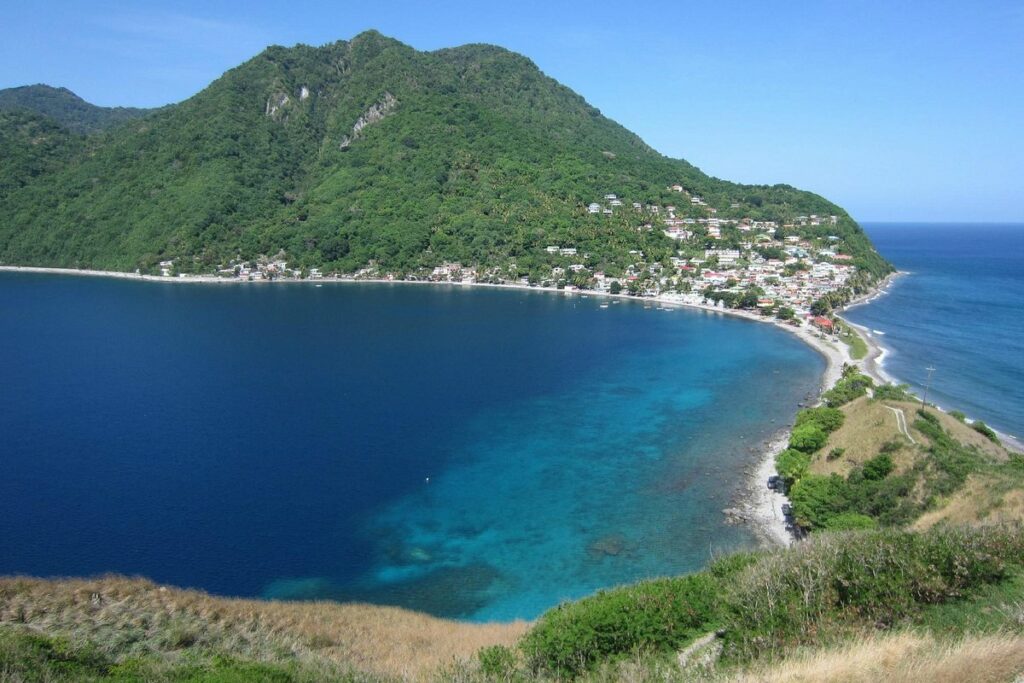
SOUFRIERE-SCOTTS HEAD MARINE RESERVE
Description
Located in the southwest of Dominica, the Soufrière-Scotts Head Marine Reserve is a bay originating from a vast extinct and submerged volcanic crater. The reserve covers about 6 to 7 square kilometers, bordering a coastline of mountains and hills. With a volcanic landscape, it is not surprising that the seascape is equally spectacular. Pinnacles, walls and large underwater rocks form different exceptional diving sites along the perimeter of the reserve. These sites: Crater’s Edge, Scott’s Head Pinnacles, L’Abym, Dangleben’s and Champagne Reef attract divers from around the world.
It is also important to mention one of the most surprising places, the Champagne reef, proof of the effects of volcanic activity and, in particular, of geothermal energy: bubbles of volcanic gas rise from the bottom of the water! And they are reminiscent of the champagne that gives rise to the name of this place. In this area, the color of the reef changes to gold and the volcanic bubbles give off a heat that is certainly unexpected in the open sea.
The marine reserve was created to avoid conflicts of use between the traditional fishing of the towns of Scotts Head and Soufrière and the diving tourism that was emerging there.
Biodiversity
The Soufriere-Scott’s Head Marine Reserve is one of the most pristine diving environments in the Caribbean, characterized by the adjacent shoreline, coral reef systems, underwater vents and steep drop offs. It is a site for schools of migratory inshore pelagic fish such as trevally, sardines and mackerel, and for cetacean species such as spinner dolphins (Stenella longirostris) and sperm whales.
Closer to the coast, the seabed is exceptional and allows you to observe fish, crustaceans and molluscs of all kinds and colors, juveniles or adults. You can also find the flamingo tongue snail (Cyphoma gibbosum), a remarkable species of gastropod mollusk.
Ecotourism potential
The SSMR (Soufrière/Scotts Head Marine Reserve) extends from Soufrière, Scotts Head to Anse Bateau, near the village of Point Michel. Shared between fishermen and divers, to allow both to enjoy the site, it is organized as follows:
To the west of the Scotts Head peninsula, Trou Sable Bay is reserved for diving. In this area, the coral reef extends to about 15m, the seabed descends vertically and along the wall, you can see corals, sponges and gorgonians.
In the center, the area is more degraded, but the quantity of fish is good and it is suitable for fishing.
Further north, from the beach in the village of Soufrière, is the “Champagne reef” and its sulfurous bubbles that reach a depth of 18 m. Here many juvenile fish are observed, it is the so-called breeding area. “Labim” further north is also reserved for diving due to the beauty of its funds.
The bay is the submerged crater of an extinct volcano that sinks to great depths and is characterized by a set of geological features that make it one of the best diving sites in the world. The richness of biodiversity as well as the originality of these sea beds make it an essential place to visit during a stay in Dominica.
Informations
-
-
Location
